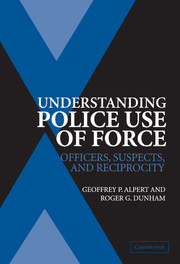Book contents
- Frontmatter
- Contents
- Acknowledgments
- Introduction: The Context of Police Use of Force
- 1 Police Use of Force: The History of Research
- 2 The Crucial Element: Finding Research Sites
- 3 Findings from Miami-Dade Police Department Study
- 4 The Sequential Steps in Use-of-Force Incidents in the Miami-Dade Police Department
- 5 Miami-Dade Police Department: Inconsistencies between Officer and Suspect Accounts of the Use of Force
- 6 Findings from Prince George's County Police Department
- 7 Findings and Summary
- 8 Explaining Police Use of Force: The Breakdown of an Authority Maintenance Ritual
- Appendix: Frequencies of Force Sequences for First through Tenth Actions
- Index
- References
1 - Police Use of Force: The History of Research
Published online by Cambridge University Press: 14 July 2009
- Frontmatter
- Contents
- Acknowledgments
- Introduction: The Context of Police Use of Force
- 1 Police Use of Force: The History of Research
- 2 The Crucial Element: Finding Research Sites
- 3 Findings from Miami-Dade Police Department Study
- 4 The Sequential Steps in Use-of-Force Incidents in the Miami-Dade Police Department
- 5 Miami-Dade Police Department: Inconsistencies between Officer and Suspect Accounts of the Use of Force
- 6 Findings from Prince George's County Police Department
- 7 Findings and Summary
- 8 Explaining Police Use of Force: The Breakdown of an Authority Maintenance Ritual
- Appendix: Frequencies of Force Sequences for First through Tenth Actions
- Index
- References
Summary
the difficulties associated with conducting research on a group such as the police that, historically, has had great power and autonomy should not be underestimated. As we have seen, the role of the police in society is one of authority with the right to use force. The right of the police to use force to fulfill their responsibilities and the fact that they work in an environment without direct supervision contribute to making abuse of this power all too easy. Unfortunately, these considerations also make it very difficult to study the police and their possible abuse of power. Given the unquestionable relevance of these issues to our society, researchers have attempted to understand and explain the phenomenon of police use and abuse of force. This book proposes a new conceptual framework for examining and assessing the use of force, a framework discussed at length in Chapter 8. A brief survey of prior research on police use-of-force is therefore both necessary and useful to demonstrate the progress that has been made in police use-of-force research, and to highlight the obstacles that remain to attaining a more complete understanding of when and why force is used in law enforcement.
An Imperfect World: Necessary Force
Since the beginning of law enforcement, people have been concerned about the use of force by the police. As early as 1215 English barons ordered restrictions placed on all sheriffs and constables to curb abuses of power by the forces of law and order.
- Type
- Chapter
- Information
- Understanding Police Use of ForceOfficers, Suspects, and Reciprocity, pp. 17 - 53Publisher: Cambridge University PressPrint publication year: 2004
References
- 1
- Cited by



